船舶动态定位系统简介
- 格式:doc
- 大小:1.87 MB
- 文档页数:50
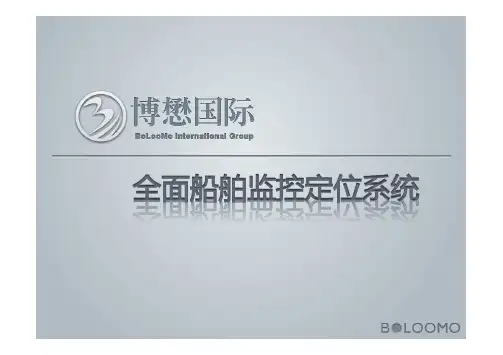
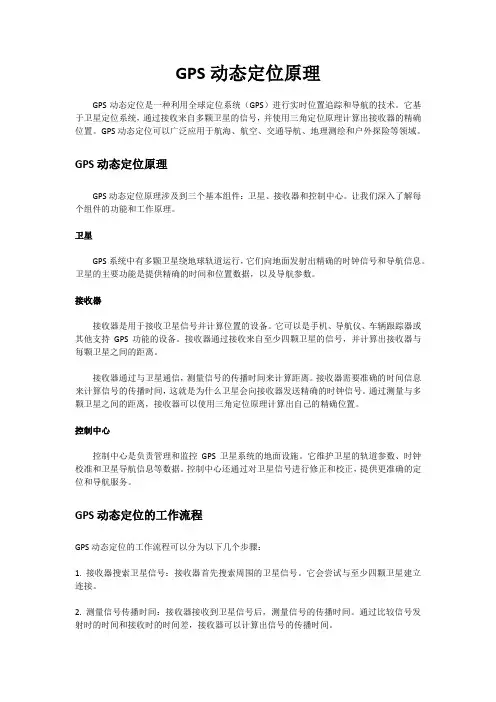
GPS动态定位原理GPS动态定位是一种利用全球定位系统(GPS)进行实时位置追踪和导航的技术。
它基于卫星定位系统,通过接收来自多颗卫星的信号,并使用三角定位原理计算出接收器的精确位置。
GPS动态定位可以广泛应用于航海、航空、交通导航、地理测绘和户外探险等领域。
GPS动态定位原理GPS动态定位原理涉及到三个基本组件:卫星、接收器和控制中心。
让我们深入了解每个组件的功能和工作原理。
卫星GPS系统中有多颗卫星绕地球轨道运行,它们向地面发射出精确的时钟信号和导航信息。
卫星的主要功能是提供精确的时间和位置数据,以及导航参数。
接收器接收器是用于接收卫星信号并计算位置的设备。
它可以是手机、导航仪、车辆跟踪器或其他支持GPS功能的设备。
接收器通过接收来自至少四颗卫星的信号,并计算出接收器与每颗卫星之间的距离。
接收器通过与卫星通信,测量信号的传播时间来计算距离。
接收器需要准确的时间信息来计算信号的传播时间,这就是为什么卫星会向接收器发送精确的时钟信号。
通过测量与多颗卫星之间的距离,接收器可以使用三角定位原理计算出自己的精确位置。
控制中心控制中心是负责管理和监控GPS卫星系统的地面设施。
它维护卫星的轨道参数、时钟校准和卫星导航信息等数据。
控制中心还通过对卫星信号进行修正和校正,提供更准确的定位和导航服务。
GPS动态定位的工作流程GPS动态定位的工作流程可以分为以下几个步骤:1. 接收器搜索卫星信号:接收器首先搜索周围的卫星信号。
它会尝试与至少四颗卫星建立连接。
2. 测量信号传播时间:接收器接收到卫星信号后,测量信号的传播时间。
通过比较信号发射时的时间和接收时的时间差,接收器可以计算出信号的传播时间。
3. 计算距离:通过信号传播时间和光速的知识,接收器可以计算出与每颗卫星之间的距离。
接收器需要至少四颗卫星的信号来进行精确的定位计算。
4. 三角定位计算位置:接收器使用三角定位原理计算出自己的精确位置。
三角定位基于测量到的卫星距离和卫星位置信息,通过数学计算确定接收器的位置坐标。

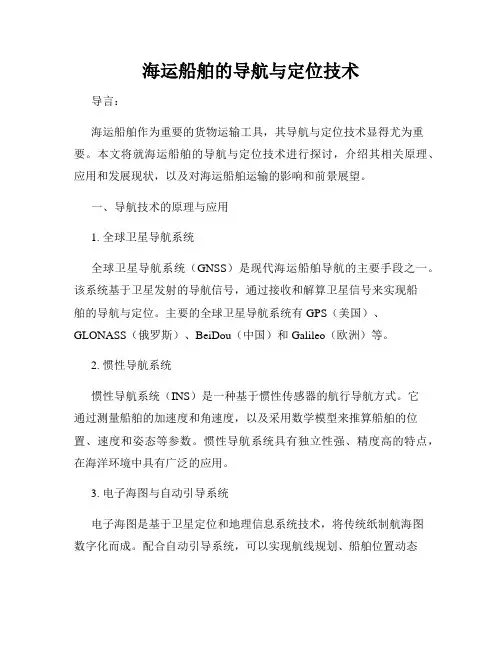
海运船舶的导航与定位技术导言:海运船舶作为重要的货物运输工具,其导航与定位技术显得尤为重要。
本文将就海运船舶的导航与定位技术进行探讨,介绍其相关原理、应用和发展现状,以及对海运船舶运输的影响和前景展望。
一、导航技术的原理与应用1. 全球卫星导航系统全球卫星导航系统(GNSS)是现代海运船舶导航的主要手段之一。
该系统基于卫星发射的导航信号,通过接收和解算卫星信号来实现船舶的导航与定位。
主要的全球卫星导航系统有GPS(美国)、GLONASS(俄罗斯)、BeiDou(中国)和Galileo(欧洲)等。
2. 惯性导航系统惯性导航系统(INS)是一种基于惯性传感器的航行导航方式。
它通过测量船舶的加速度和角速度,以及采用数学模型来推算船舶的位置、速度和姿态等参数。
惯性导航系统具有独立性强、精度高的特点,在海洋环境中具有广泛的应用。
3. 电子海图与自动引导系统电子海图是基于卫星定位和地理信息系统技术,将传统纸制航海图数字化而成。
配合自动引导系统,可以实现航线规划、船舶位置动态显示、预警和碰撞避让等功能。
这一技术的应用大大提高了船舶的导航安全性和效率。
二、定位技术的原理与应用1. 水文测量与声纳定位水文测量技术可以通过测量水深和水下地貌,辅助船舶的定位和导航。
声纳定位则利用声波在水中的传播速度和回波反射信号,通过接收和处理声纳信号来确定船舶的位置和方位。
2. 雷达定位雷达定位技术是利用雷达发射出的电磁波与物体相互作用的原理,通过接收物体反射回来的波束来确定物体的位置和运动情况。
雷达定位技术在海运船舶的目标识别和位置确认方面具有重要作用。
3. 卫星通信与无线电定位卫星通信技术可以实现船舶与岸上通信基站的远距离通信,为船舶导航和定位提供重要信息。
无线电定位技术则基于无线电波的传播特性,通过地面测量站对船舶的无线电信号进行测量和分析,来确定船舶的位置。
三、海运船舶导航与定位技术的发展现状随着科技的不断进步,海运船舶导航与定位技术也在不断发展。
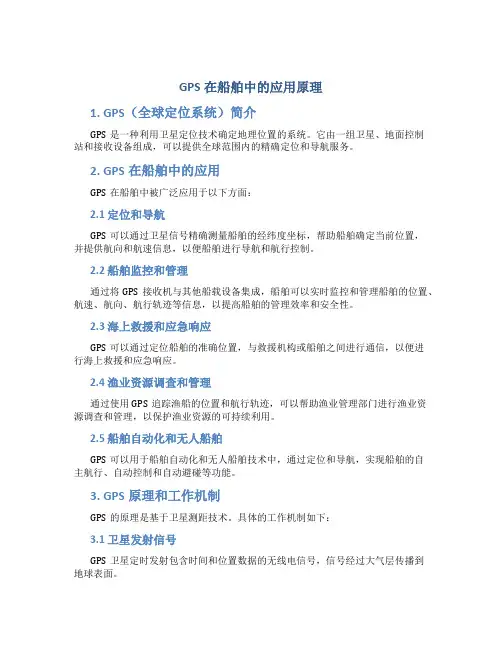
GPS在船舶中的应用原理1. GPS(全球定位系统)简介GPS是一种利用卫星定位技术确定地理位置的系统。
它由一组卫星、地面控制站和接收设备组成,可以提供全球范围内的精确定位和导航服务。
2. GPS在船舶中的应用GPS在船舶中被广泛应用于以下方面:2.1 定位和导航GPS可以通过卫星信号精确测量船舶的经纬度坐标,帮助船舶确定当前位置,并提供航向和航速信息,以便船舶进行导航和航行控制。
2.2 船舶监控和管理通过将GPS接收机与其他船载设备集成,船舶可以实时监控和管理船舶的位置、航速、航向、航行轨迹等信息,以提高船舶的管理效率和安全性。
2.3 海上救援和应急响应GPS可以通过定位船舶的准确位置,与救援机构或船舶之间进行通信,以便进行海上救援和应急响应。
2.4 渔业资源调查和管理通过使用GPS追踪渔船的位置和航行轨迹,可以帮助渔业管理部门进行渔业资源调查和管理,以保护渔业资源的可持续利用。
2.5 船舶自动化和无人船舶GPS可以用于船舶自动化和无人船舶技术中,通过定位和导航,实现船舶的自主航行、自动控制和自动避碰等功能。
3. GPS原理和工作机制GPS的原理是基于卫星测距技术。
具体的工作机制如下:3.1 卫星发射信号GPS卫星定时发射包含时间和位置数据的无线电信号,信号经过大气层传播到地球表面。
3.2 接收机接收信号船舶上的GPS接收机接收到从多颗卫星发射的信号,并将其解码和处理。
3.3 信号测量和计算GPS接收机测量每个接收到的卫星信号的传播时间,并通过计算传播时间差来确定船舶的位置。
3.4 定位和导航计算GPS接收机根据接收到的卫星信号和测量数据,使用三角计算方法确定船舶的经纬度坐标和航向。
4. GPS精度和误差GPS在船舶应用中的精度和误差受多种因素影响,包括但不限于以下因素:4.1 卫星配置卫星的选择和分布会影响GPS的定位精度和可见性。
4.2 大气层延迟大气层中的离子层和对流层会对GPS信号产生延迟,导致定位误差。
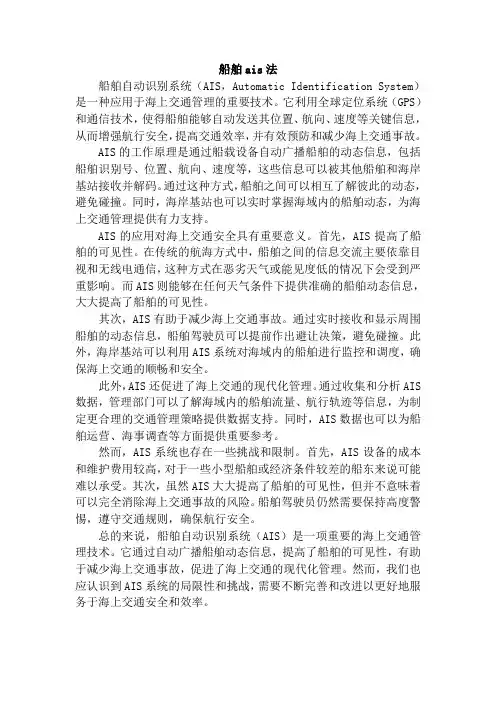
船舶ais法船舶自动识别系统(AIS,Automatic Identification System)是一种应用于海上交通管理的重要技术。
它利用全球定位系统(GPS)和通信技术,使得船舶能够自动发送其位置、航向、速度等关键信息,从而增强航行安全,提高交通效率,并有效预防和减少海上交通事故。
AIS的工作原理是通过船载设备自动广播船舶的动态信息,包括船舶识别号、位置、航向、速度等,这些信息可以被其他船舶和海岸基站接收并解码。
通过这种方式,船舶之间可以相互了解彼此的动态,避免碰撞。
同时,海岸基站也可以实时掌握海域内的船舶动态,为海上交通管理提供有力支持。
AIS的应用对海上交通安全具有重要意义。
首先,AIS提高了船舶的可见性。
在传统的航海方式中,船舶之间的信息交流主要依靠目视和无线电通信,这种方式在恶劣天气或能见度低的情况下会受到严重影响。
而AIS则能够在任何天气条件下提供准确的船舶动态信息,大大提高了船舶的可见性。
其次,AIS有助于减少海上交通事故。
通过实时接收和显示周围船舶的动态信息,船舶驾驶员可以提前作出避让决策,避免碰撞。
此外,海岸基站可以利用AIS系统对海域内的船舶进行监控和调度,确保海上交通的顺畅和安全。
此外,AIS还促进了海上交通的现代化管理。
通过收集和分析AIS 数据,管理部门可以了解海域内的船舶流量、航行轨迹等信息,为制定更合理的交通管理策略提供数据支持。
同时,AIS数据也可以为船舶运营、海事调查等方面提供重要参考。
然而,AIS系统也存在一些挑战和限制。
首先,AIS设备的成本和维护费用较高,对于一些小型船舶或经济条件较差的船东来说可能难以承受。
其次,虽然AIS大大提高了船舶的可见性,但并不意味着可以完全消除海上交通事故的风险。
船舶驾驶员仍然需要保持高度警惕,遵守交通规则,确保航行安全。
总的来说,船舶自动识别系统(AIS)是一项重要的海上交通管理技术。
它通过自动广播船舶动态信息,提高了船舶的可见性,有助于减少海上交通事故,促进了海上交通的现代化管理。
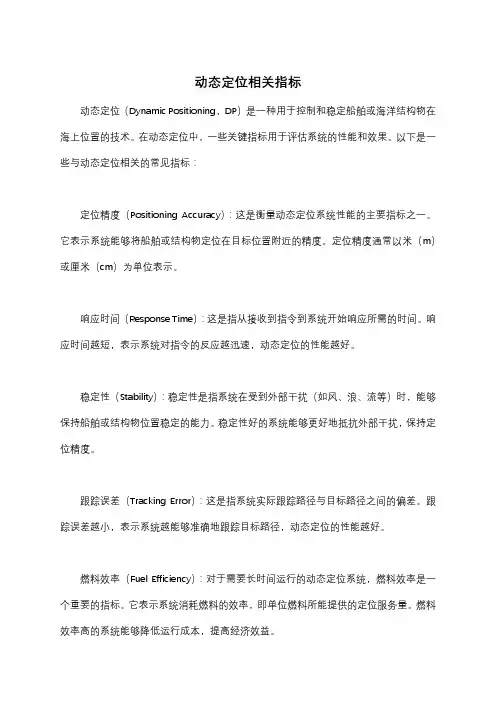
动态定位相关指标
动态定位(Dynamic Positioning,DP)是一种用于控制和稳定船舶或海洋结构物在海上位置的技术。
在动态定位中,一些关键指标用于评估系统的性能和效果。
以下是一些与动态定位相关的常见指标:
定位精度(Positioning Accuracy):这是衡量动态定位系统性能的主要指标之一。
它表示系统能够将船舶或结构物定位在目标位置附近的精度。
定位精度通常以米(m)或厘米(cm)为单位表示。
响应时间(Response Time):这是指从接收到指令到系统开始响应所需的时间。
响应时间越短,表示系统对指令的反应越迅速,动态定位的性能越好。
稳定性(Stability):稳定性是指系统在受到外部干扰(如风、浪、流等)时,能够保持船舶或结构物位置稳定的能力。
稳定性好的系统能够更好地抵抗外部干扰,保持定位精度。
跟踪误差(Tracking Error):这是指系统实际跟踪路径与目标路径之间的偏差。
跟踪误差越小,表示系统越能够准确地跟踪目标路径,动态定位的性能越好。
燃料效率(Fuel Efficiency):对于需要长时间运行的动态定位系统,燃料效率是一个重要的指标。
它表示系统消耗燃料的效率,即单位燃料所能提供的定位服务量。
燃料效率高的系统能够降低运行成本,提高经济效益。
这些指标通常用于评估动态定位系统的性能、优化系统配置以及改进系统设计。
在实际应用中,根据不同的需求和场景,可能还需要考虑其他指标,如系统可靠性、维护成本等。
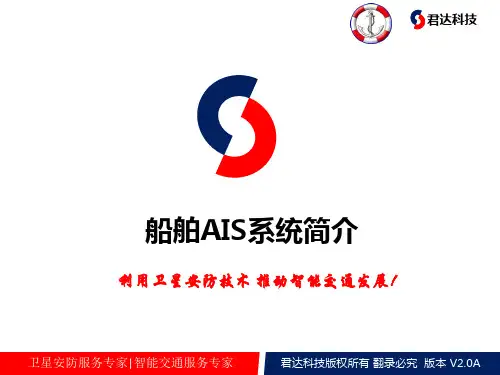
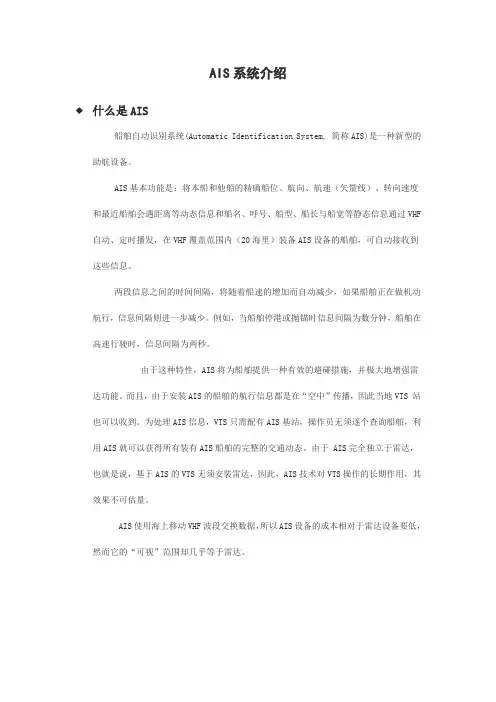
AIS系统介绍什么是AIS船舶自动识别系统(Automatic Identification System, 简称AIS)是一种新型的助航设备。
AIS基本功能是:将本船和他船的精确船位、航向、航速(矢量线)、转向速度和最近船舶会遇距离等动态信息和船名、呼号、船型、船长与船宽等静态信息通过VHF 自动、定时播发,在VHF覆盖范围内(20海里)装备AIS设备的船舶,可自动接收到这些信息。
两段信息之间的时间间隔,将随着船速的增加而自动减少,如果船舶正在做机动航行,信息间隔则进一步减少。
例如,当船舶停港或抛锚时信息间隔为数分钟,船舶在高速行驶时,信息间隔为两秒。
由于这种特性,AIS将为船舶提供一种有效的避碰措施,并极大地增强雷达功能。
而且,由于安装AIS的船舶的航行信息都是在“空中”传播,因此当地VTS 站也可以收到。
为处理AIS信息,VTS只需配有AIS基站,操作员无须逐个查询船舶,利用AIS 就可以获得所有装有AIS船舶的完整的交通动态。
由于 AIS完全独立于雷达,也就是说,基于AIS的VTS无须安装雷达,因此,AIS技术对VTS操作的长期作用,其效果不可估量。
AIS使用海上移动VHF波段交换数据,所以AIS设备的成本相对于雷达设备要低,然而它的“可视”范围却几乎等于雷达。
研制AIS的起因和背景VTS、ARPA雷达的长足发展通过岸基雷达搜集目标信号的船舶港口交通管理系统被称为VTS,通过船基雷达搜集目标信号并显示目标的航向、航速以及能模拟避碰的雷达被称为ARPA避碰雷达。
二十世纪七、八十年代,是VTS、ARPA雷达长足发展的黄金时期,几乎全球的所有的港口都安装了VTS,全部的远航船舶都安装了ARPA雷达。
从1978年到1999年的21年间,我国就建造了20个不同规模、不同类型的VTS站(不包括台湾)。
VTS、ARPA雷达比以前的同类产品的性能的确提高了一大步,一时被人们用完美无缺来形容。
随着航海事业的发展和人们航海通信导航仪器的要求提高,VTS和ARPA雷达无法直接标识目标的问题就突出了。
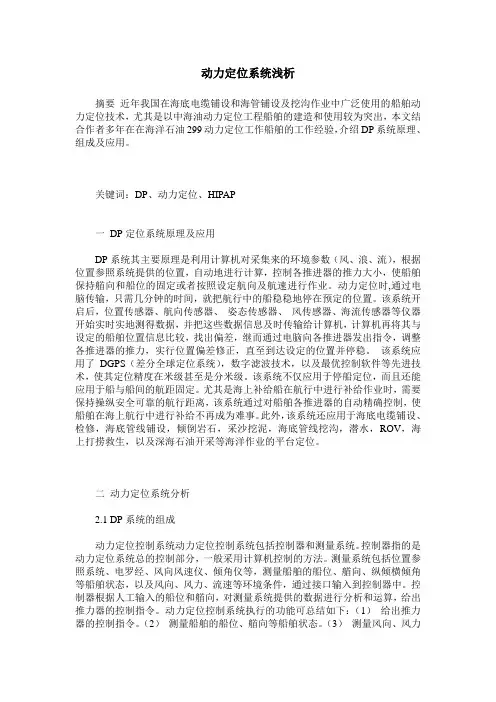
动力定位系统浅析摘要近年我国在海底电缆铺设和海管铺设及挖沟作业中广泛使用的船舶动力定位技术,尤其是以中海油动力定位工程船舶的建造和使用较为突出,本文结合作者多年在在海洋石油299动力定位工作船舶的工作经验,介绍DP系统原理、组成及应用。
关键词:DP、动力定位、HIPAP一DP定位系统原理及应用DP系统其主要原理是利用计算机对采集来的环境参数(风、浪、流),根据位置参照系统提供的位置,自动地进行计算,控制各推进器的推力大小,使船舶保持艏向和船位的固定或者按照设定航向及航速进行作业。
动力定位时,通过电脑传输,只需几分钟的时间,就把航行中的船稳稳地停在预定的位置。
该系统开启后,位置传感器、航向传感器、姿态传感器、风传感器、海流传感器等仪器开始实时实地测得数据,并把这些数据信息及时传输给计算机,计算机再将其与设定的船舶位置信息比较,找出偏差,继而通过电脑向各推进器发出指令,调整各推进器的推力,实行位置偏差修正,直至到达设定的位置并停稳。
该系统应用了DGPS(差分全球定位系统),数字滤波技术,以及最优控制软件等先进技术,使其定位精度在米级甚至是分米级。
该系统不仅应用于停船定位,而且还能应用于船与船间的航距固定。
尤其是海上补给船在航行中进行补给作业时,需要保持操纵安全可靠的航行距离,该系统通过对船舶各推进器的自动精确控制,使船舶在海上航行中进行补给不再成为难事。
此外,该系统还应用于海底电缆铺设、检修,海底管线铺设,倾倒岩石,采沙挖泥,海底管线挖沟,潜水,ROV,海上打捞救生,以及深海石油开采等海洋作业的平台定位。
二动力定位系统分析2.1 DP系统的组成动力定位控制系统动力定位控制系统包括控制器和测量系统。
控制器指的是动力定位系统总的控制部分,一般采用计算机控制的方法。
测量系统包括位置参照系统、电罗经、风向风速仪、倾角仪等,测量船舶的船位、艏向、纵倾横倾角等船舶状态,以及风向、风力、流速等环境条件,通过接口输入到控制器中。
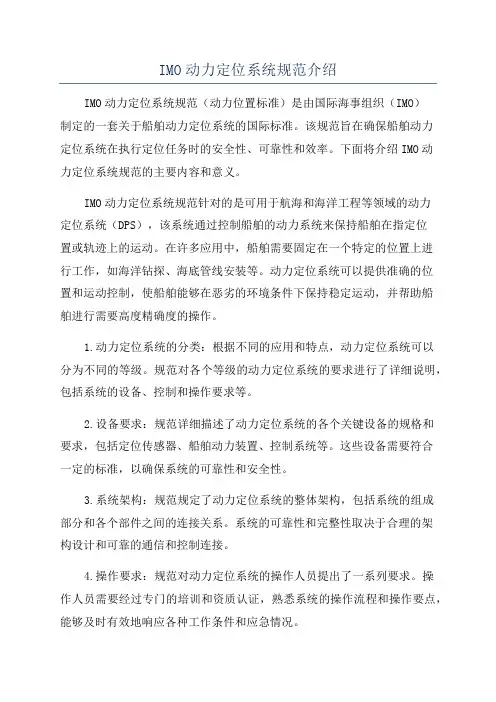
IMO动力定位系统规范介绍IMO动力定位系统规范(动力位置标准)是由国际海事组织(IMO)制定的一套关于船舶动力定位系统的国际标准。
该规范旨在确保船舶动力定位系统在执行定位任务时的安全性、可靠性和效率。
下面将介绍IMO动力定位系统规范的主要内容和意义。
IMO动力定位系统规范针对的是可用于航海和海洋工程等领域的动力定位系统(DPS),该系统通过控制船舶的动力系统来保持船舶在指定位置或轨迹上的运动。
在许多应用中,船舶需要固定在一个特定的位置上进行工作,如海洋钻探、海底管线安装等。
动力定位系统可以提供准确的位置和运动控制,使船舶能够在恶劣的环境条件下保持稳定运动,并帮助船舶进行需要高度精确度的操作。
1.动力定位系统的分类:根据不同的应用和特点,动力定位系统可以分为不同的等级。
规范对各个等级的动力定位系统的要求进行了详细说明,包括系统的设备、控制和操作要求等。
2.设备要求:规范详细描述了动力定位系统的各个关键设备的规格和要求,包括定位传感器、船舶动力装置、控制系统等。
这些设备需要符合一定的标准,以确保系统的可靠性和安全性。
3.系统架构:规范规定了动力定位系统的整体架构,包括系统的组成部分和各个部件之间的连接关系。
系统的可靠性和完整性取决于合理的架构设计和可靠的通信和控制连接。
4.操作要求:规范对动力定位系统的操作人员提出了一系列要求。
操作人员需要经过专门的培训和资质认证,熟悉系统的操作流程和操作要点,能够及时有效地响应各种工作条件和应急情况。
5.安全要求:规范关注船舶动力定位系统在遭遇各种异常情况时的安全性问题。
例如,如果发生系统故障、定位传感器失效或动力装置故障等情况,系统应该能够自动切换到备用方案或发出警报来保证船舶的安全。
IMO动力定位系统规范对船舶动力定位系统的设计、制造、安装和操作均提出了严格要求,以确保系统在实际应用中的可靠性和安全性。
这些规范为动力定位系统的生产商、供应商和用户提供了参考标准,为航海和海洋工程提供了有力的技术支持。
船舶动力定位技术简述船舶动力定位技术简介动力定位技术背景随着船舶作业任务的复杂化,动力定位技术逐渐成为船舶自动化控制领域的研究热点。
目前,国际上主要的动力定位系统制造商有___、___、___等。
动力定位控制系统测量系统是指动力定位系统的位置参考系统和传感器。
位置参考系统主要采用DGPS,水声位置参考系统主要选择超短基线或长基线声呐,微波位置参考系统可选择Artemis Mk 4,张紧索位置参考系统可选择LTW Mk,激光位置参考系统可选择Fanbeam Mk 4,雷达位置参考系统可选择RADius 500X。
罗经、风传感器、运动参考单元等同样选择各专业生产厂家的产品。
控制技术动力定位系统的第一代产品采用经典控制理论来设计控制器,通常采用常规的PID控制规律。
第二代动力定位控制方法是以现代控制理论为基础的控制技术-最优控制和卡尔曼滤波理论相结合。
近年来出现的第三代动力定位系统采用了智能控制理论和方法,使动力定位控制进一步向智能化的方向发展。
智能控制方法主要体现在鲁棒控制、模糊控制、非线性模型预测控制等方面。
2001年5月份,挪威的___推出了一项新产品—绿色动力定位系统(Green DP),将非线性模型预测控制技术成功地引入到动力定位系统中。
Green DP控制器由环境补偿器和模型预测控制器组成。
环境补偿器的设计是为了提供一个缓慢变化的推力指令来补偿一般的环境作用力。
模型预测控制器是通过不断求解一个精确的船舶非线性动态数学模型,用以预测船舶的预期行为。
模型预测控制算法的计算比一般用于动力定位传统的控制器设计更加复杂且更为耗时,主要有三个步骤:1.从非线性船舶模型预测运动;2.寻找阶跃响应曲线;3.求解最佳推力。
控制器结构如图所示:在20世纪80年代初期,荷兰的Marin确定了推进器和动力定位的研究计划,并进行了动力定位的模型实验。
这些实验包括推进器和推进器之间的相互作用、推进器和船体之间的相互作用以及环境力和船舶的低频运动等内容。
给定的最严峻环境条件给定的最严峻环境条件系指船舶作业区域内的最大风速﹑流速与浪高。
根据不同工况要求和操作要求,调整DP等级,以降低能耗和对周边环境的影响。
主要DP控制系统供应商“绿色DP” 控制系统控制器全回转推进器硬线或网络侧推推进用推进器一般的位置测量设备•扇形波束测位仪(激光技术)Fan Beam (Laser Technique)•张紧索(测垂向倾角);Taut Wire (Vertical Angle)•差分式全球卫星定位系统DGPS (借助卫星)•水下声学定位系统HPR (有长﹑短基线等方法,需水下声学应答器,水下声学技术);HPR(Long &Short Base, Hydro‐acoustic, Transponders)•Atriums (无线电波,需要岸上参考目标,适用于特定位置)Atriums (Radio Wave, Landmark, SpecificSite)•其他设备Others联合操纵杆零级定位DPS‐0适用于安装有动力定位系统的船舶,它具有集中手动位置控制和自动艏向控制,在给定的最严峻环境条件下,能保持船舶的位置和艏向。
For vessels which are fitted with a dynamicpositioning system with centralized manual positioncontrol and automatic heading control to maintain the position and heading under the specifiedmaximum environmental conditions.一个典型的DPS‐2系统内部构成A Typical DPS‐2 Configuration双操作站双控制器三级定位DPS‐3适用于安装有动力定位系统的船舶,在给定的最严峻环境条件下,包括发生任何单一故障(包括由于火灾或水灾而失去整个舱室),能自动保持船舶的位置和艏向在给定的运行范围内。
动力定位DP(Dynamically positioned)的定义是一种可以不用锚系而自动保持海上浮动装置的定位方法。
动力定位系统由船位显示仪、电子计算机控制机构和推进器等部件组成。
工作时,电子计算机随时可根据船位仪所测定的船位数值,自动地发出控制信号,改变推进器的运转方向、转速或叶片的螺矩,以调节船位。
有的动力定位系统,还可根据风力的变化,提前发出信号来抵消风力的影响。
采用动力定位的海上浮动装置,在海上钻探作业时不需要抛锚,这不仅减少了复杂的抛锚工序,而且工作的水深亦不受锚系长度的限制,甚至可以在水深大于1000米以上的深度进行工作。
DP3是动力定位的等级,3级是最高的一种.不过各船级设对动力的定位等级的名称描述不全相同,像DNV的就叫的比较另类~~DP3是最高等级的了,冗余多,安全好,一般平台上采用,钻井船的话DP2多点。
动力定位需要接收GPS,,卫星信号,电罗经的信号等信号,并且点罗经要配备多个,还要配备参照设备,并将这些信号送到动力定位系统,然后动力定位系统的计算机根据这些信息计算怎样控制推进器的动作。
动力定位系统设计时要根据船舶的服务海域,假设出船所受的浪高,浪的周期,风速,洋流速,并且要不同角度计算,才能设计出一个合理的动力定位系统。
DP控制系统1 ,一般来说,DP控制系统布置在DP控制站里,在该控制站操作人员可以清楚看到船的外形轮廓及周边区域。
DP控制站应该显示来自动力、推进和DP控制系统的信息,以确保这些系统正常运行。
对安全操作DP系统必需的信息必须一致可见。
其它信息应该基于操作员要求可用。
3 ,特别地,显示系统和DP控制站应该基于声环境学原理。
DP控制系统应该提供控制模式的简单选择,比如手动、操纵杆、或推进的电脑控制,并且应该清楚地显示出现运行的模式。
4,对配备2和3级的,操作控制必须设计为没有单个误操作可能导致临界条件。
5 ,相关接口的系统和/或DP控制系统控制的系统的错误报警必须是声光报警。
船舶动力定位系统及其控制技术随着海洋经济时代的到来,人们对海洋资源的需求越来越多。
由于深海环境复杂多变,因而对获取海洋资源的装置定位精度要求也越来越高。
传统的锚泊系统有抛起锚操作过程繁琐、定位精度和机动性差等缺陷,难以符合定位精度的要求;而船舶动力定位系统(以下简称“DP系统”)则在保持航迹或保持位置方面具有突出的优势,已被逐渐应用到海上航行船舶和作业平台上,快速发展的控制理论在DP系统中的应用,取得了很好效果。
1 DP系统概述1.1 定义DP系统是指不依靠外界的辅助,通过固有的动力装置来对船舶或作业平台进行定位的一种闭环控制系统,系统包括控制系统、测量系统和推进系统,控制系统是其核心。
1.2 组成DP系统由控制系统、测量系统和推力系统组成。
控制系统是整个系统的核心,对测得的信息和外界干扰信号进行处理,能够通过计算推算出抵抗外界干扰的推力,并传递给推力系统。
测量系统能够获得船舶運动所需要的信息,其种类有DGPS、电罗经、张紧索系统、水下声呐系统、垂直参考系统、风力传感器等。
推力系统根据控制系统计算出的推力来控制船舶。
1.3 研究状况第1代DP系统的研发始于1960年。
钻井船“Eureka”号是世界上第一艘基于自动控制原理设计的DP船舶。
该船配备的DP模拟系统与外界张紧索系统相连。
该船除装有主推力系统外,在还在船首和船尾装有侧推力系统,在船身底部也安装有多台推进器。
第2代DP系统始于1970年,具有代表性的是“*****5”号船,该船安装有多台推进器,系统的控制器采用kalman滤波等现代控制技术,且控制系统中的元件有冗余,其安全性、稳定性和作业时间均有了较大的改善和提高。
第3代DP系统始于1980年。
系统采用微机处理技术和Muti-bus、Vme等多总线标准的控制系统。
代表性的第3代DP系统有挪威Konsberg公司的AD-P100、AD-P503系列产品和法国的DPS800系列产品。
我国对DP系统的研究开展得较晚,研究力量集中在高校和科研院所。
船舶导航系统工作原理船舶导航系统是船舶上至关重要的设备之一,它通过一系列先进的技术和设备,来确保船舶在航行过程中的安全和准确导航。
船舶导航系统主要包括GPS卫星导航系统、雷达系统、电子海图以及自动舵等多种设备。
一、GPS卫星导航系统GPS卫星导航系统是一种基于卫星信号的全球定位系统,它由一系列卫星和接收设备构成。
GPS系统可以通过接收卫星发射的信号来确定船舶的位置、航向和速度等关键信息。
GPS导航系统的工作原理是通过接收至少3颗卫星的信号,来计算出自身的位置,通过接收更多卫星的信号,可以进一步提高定位的精准度。
在船舶导航中,GPS系统可以实时监测船舶的位置,自动更新导航数据,提供精准的航行信息。
通过GPS系统,船舶可以在海洋中准确导航,在复杂的环境中有效避开障碍物,并且可以及时调整航向和速度,确保船舶的航行安全。
二、雷达系统雷达系统是船舶上常用的安全设备,它可以通过发射和接收无线电波,来探测远处的障碍物、其他船只以及陆地等。
雷达系统通过测量目标物体反射回来的电磁波的时间和方向,来确定目标物体的位置、距离和大小等信息。
在船舶导航中,雷达系统可以提供远距离的目标检测能力,帮助船长及时发现前方的障碍物和其他船只,避免碰撞和其他危险情况。
雷达系统还可以提供航向线和距离测量服务,帮助船舶确定安全的航线和航行距离。
三、电子海图电子海图是一种通过电子设备显示的海图,它可以实时更新航行信息、水深、潮汐和地理环境等数据。
电子海图系统可以与GPS卫星导航系统和雷达系统等设备连接,提供全面的航行信息和导航功能。
电子海图系统的工作原理是通过接收卫星定位和船舶自身的传感器数据,来实时更新地图显示的航行信息。
船舶可以通过电子海图系统来确定最佳的航行路径,避开浅滩和其他障碍物,同时还可以显示目标物体的位置和形状等信息。
四、自动舵自动舵是船舶导航系统中的关键设备,它可以根据预设的航行路径和指令,自动调整舵机和推进器的角度,来控制船舶的航向和速度。
动力定位系统的发展历程与趋势动力定位系统是一种利用船舶或其他移动设备上的动力装置进行精确定位和控制的技术。
它通过使用动力系统以及传感器和自动控制系统,使船舶能够稳定地保持在指定位置,以实现各种海洋工程作业、科学研究以及海上运输等任务。
下面将详细介绍动力定位系统的发展历程以及当前的趋势。
动力定位的概念最早可以追溯到20世纪50年代。
起初,人们使用定向推进器和锚泊系统来尝试控制船舶的位置。
然而,这些方法存在许多限制,如受环境因素的影响、操纵不灵活等。
直到20世纪60年代初,动力定位系统才得到了进一步的发展。
首先是加拿大的一家石油公司成功地开发了第一个商用动力定位系统,用于石油开采作业。
此后,动力定位系统逐渐应用于其他领域,如海底油气勘探、深海建筑、海上风电等。
随着技术的不断改进,动力定位系统的可用性和精度得到了显著提高。
传感器技术的发展使得船舶能够实时获取和分析海洋环境的数据,从而更好地适应变化的海况条件。
自动控制系统的进步使得船舶能够更精确地控制自身位置和姿态,提高工作效率和安全性。
另外,与传统的定位系统相比,动力定位系统更加灵活和可靠。
传统的定位系统主要依赖卫星导航,而动力定位系统可以通过船舶上的多个定位传感器,如全球定位系统(GPS)、惯性导航系统(INS)、声呐以及相机等,综合使用以提高定位的准确性和鲁棒性。
这种多传感器融合的方式不仅提高了定位系统的可靠性,还降低了船舶在弱信号环境中的依赖性。
当前,动力定位系统在海洋工程中的应用越来越广泛。
它被广泛运用于海上石油开采、海底勘探、海上风电以及深海建筑等领域。
随着人类对深海资源的需求不断增加,动力定位系统扮演着至关重要的角色。
它使得深海作业更加安全高效,同时也减少了对人力资源的依赖。
未来,动力定位系统的发展趋势仍然充满潜力。
一方面,随着无人船舶技术的不断发展,动力定位系统将在无人船舶上得到广泛应用。
这将进一步提高海洋工程的自主性和自动化程度。
另一方面,随着船舶控制技术的改进和创新,动力定位系统的精度和稳定性将得到进一步提高。
Introduction to DP 1 - Introduction Dynamic positioning (DP) is a rapidly maturing technology, having been born of necessity as a result of the increasing demands of the rapidly expanding oil and gas exploration industry in the 1960s and early 1970s. Even now, when there exist over 1,000 DP-capable vessels, the majority of them are operationally related to the exploration or exploitation of oil and gas reserves.
动态定位系统是一个快速成熟的技术。是基于1960年代到70年代油气勘探工业的需求的基础上产生的。目前已经有超过1000艘以上的动态定位的船舶,其中绝大部分都后油气勘探有关。
The demands of the offshore oil and gas industry have brought about a whole new set of requirements. Further to this, the more recent moves into deeper waters and harsh-environment locations, together with the requirement to consider more environmental-friendly methods, has brought about the great development in the area of Dynamic Positioning techniques and technology.
油气工业的需求给我们带来了一个全新的需求。不仅如此,随着油气工业向深海及更艰苦的区域发展,同时考虑到环保方式,这给动态定位系统在技术及工艺方面带来了巨大的发展。
The first vessel to fulfil the accepted definition of DP was the "Eureka", of 1961, designed and engineered by Howard Shatto. This vessel was fitted with an analogue control system of very basic type, interfaced with a taut wire reference. Equipped with steerable thrusters fore and aft in addition to her main propulsion, this vessel was of about 450 tons displacement and length 130 feet.
第一条动态定位系统概念的船”Eureka”,建于1961年,由Howard Shatto设计和制造。这条船安装着由非常简形式的模拟控制系统,配备有张力线做为参考。在主推力系统之外,有配备了前后可操作的推进系统。该船长130英尺,排水量约450吨。
By the late 1970s, DP had become a well established technique. In 1980 the number of DP capable vessels totalled about 65, while by 1985 the number had increased to about 150. Currently (2002) it stands at over 1,000 and is still expanding. It is interesting to note the diversity of vessel types and functions using DP, and the way that, during the past twenty years, this has encompassed many functions unrelated to the offshore oil and gas industries. A list of activities executed by DP vessels would include the following:
到了70年代晚期,动态定位已经确立为一门技术。到1980年,带DP功能的船舶就达到了65艘。而到了1985年,这个数字就达到了150。目前(2002),这个数字已经高达1000,而且还在迅速扩张。很有趣的是,很多的船形都在使用DP技术。 而且,在过去的20年里,其中的很多功能已经不再局限于海洋工程油气工业。下面的清单就是主要应用DP技术的船舶类型 Coring //地层取样 exploration drilling (core sampling) 取样钻井 production drilling 石油钻井 diver support 潜水支持 pipelay (rigid and flexible pipe) 铺管(硬/软管) cable lay and repair 铺管及维修 multi-role accommodation or 'flotel' services 浮动旅馆 hydrographic survey 水位检验 pre- or post-operational survey wreck survey, salvage and removal 救助船 Dredging 挖泥船 rockdumping (pipeline protection) 管道保护用岩石倾倒船 subsea installation 海底安装 lifting (topsides and subsea) 重吊(海面 及 海底) well stimulation and workover platform supply 平台支持船 shuttle tanker offtake 穿梭油轮 Floating production (with or without storage) 浮油装置 heavy lift cargo transport 重吊货运 passenger cruises 巡游客船 mine countermeasures 排雷船 oceanographical research 海洋学研究 seabed mining 海床探矿
DP is also used in rocket launch platform positioning 火箭发射平台定位 repair/maintenance support to military vessels 军船的修理和维护 ship-to-ship transfer and 船船间转移 manoeuvring conventional vessels 货物容器间调整 DP systems have become more sophisticated and complicated, as well as more reliable. Computer technology has developed rapidly and some vessels have been upgraded twice with new DP control systems. Position reference systems and other peripherals are also improving and redundancy is provided on all vessels designed to conduct higher-risk operations1.
DP系统现在 变得越来越精密而且复杂。而且更可靠。随着计算机技术的快速发展,一些船舶已经多次更新,成为了全新的DP控制系统。位置参考系统和其他外围设备也在快速发展,冗余设计在有效控制着高风险操作。
1.1 - Station Keeping There are other methods for vessel station keeping. These include spread and fixed moorings or combinations of each. Jack-ups fix their position by lowering legs to penetrate the sea bed. Vessels using moorings or legs may also occasionally have DP control systems to assist the setting-up on position and, in the case of a moored unit, to reduce mooring line tension. Each system has advantages and disadvantages.
还有其他方式进行平台保持。这些包括多点系泊,以即固定系泊,或者并列平台。自升式平台通过插入海床的支撑腿来固定位置。船舶通过系泊或支撑腿来固定位置时,偶偶也用DP来辅助定位。或用动态定位来减轻系泊绳的张力。每个系统都有他们的优点和缺点。 Sketch 1.1 station keeping methods DP Advantages: DP的优点 ▪ Vessel is fully self-propelled; no tugs are required at any stage of the operation 船舶有自己的动力。 ▪ Setting-up on location is quick and easy 固定位置快而起容易 ▪ Vessel is very manoeuvrable 船舶易于操纵 ▪ Rapid response to weather changes is possible (weather vane) 可以快速应对气候变化 ▪ Rapid response to changes in the requirements of the operation 可以快速应对操作变化 ▪ Versatility within system (i.e. track-follow, ROV-follow and other specialist functions) 更多的操作功能 ▪ Ability to work in any water depth 可以适应各种水深 ▪ Can complete short tasks more quickly, thus more economically 快速完成小任务 ▪ Avoidance of risk of damaging seabed hardware from mooring lines and anchors 避免海床上的硬损伤 ▪ Avoidance of cross-mooring with other vessels or fixed platforms 避免和其他平台交叉锚泊绳缆 ▪ Can move to new location rapidly (also avoid bad weather) 可以频繁的移到到新位置